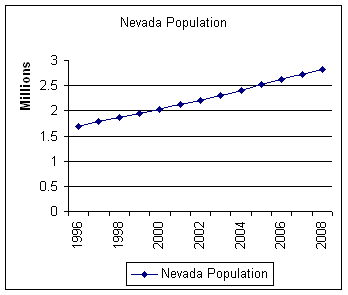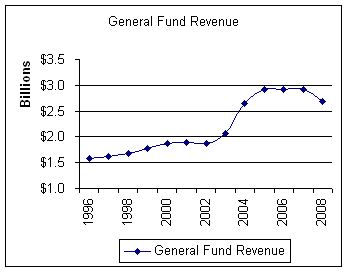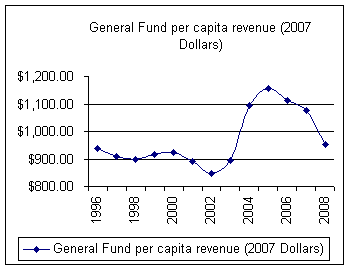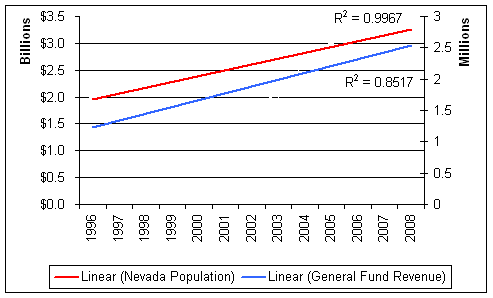Pictures are worth a thousand journalists
Jon Ralston's latest column in In Business Las Vegas not only claims that Nevada needs to raise taxes to address its budget shortfall, but that everyone who opposes tax hikes should be ignored.
But a one-sided debate is like a one-handed clapping contest, so let's review the facts.
The left contends that Nevada's budget has been unable to keep up with the state's booming population. The revenue shortfall means that the state cannot provide basic services for the people. Forgetting for the moment what defines "basic services," we'll move on...

Yup, Nevada's population growth is booming – so the Left is right about that. Nevada's population has increased an estimated 67 percent from 1996-2008.

And here is Nevada's General Fund revenue (adjusted to 2007 dollar values). General fund revenue increased an estimated 69 percent from 1996-2008.
Take note of these dates: 1997-1998 was the time of the Asian financial crisis that rocked the global market, causing a downturn in the American economy. 1999-2000 saw the dot-com boom, which was popped in the post-9/11 economy of 2001-2003.
Nevada saw stagnating revenues and a growing population in 2002-2003 (also thanks to a weak national economy) and implemented a new tax that would take effect in 2004 and usher in "windfall" tax receipts for the government.
The national economy would blast off in 2004-2006 and start to see a slowdown and crash in 2007. Basically, Nevada's government rode atop a new tax that was riding atop a booming national economy.
So while many states were hit hard by the recession, Nevada made its situation worse by drastically ramping up spending during our booming economy of the mid-2000s.
So does general fund revenue keep pace with population growth?

If you looked at 2005 as your base figure, then you could easily claim that Nevada's revenues were not keeping pace with population growth. Every year since 2005, Nevada's general fund revenue per capita has declined.
But when you start at the top of the mountain, any step you take is downhill.
Despite this decline, Nevada will still collect more general fund revenue per capita in 2008 than in 1996. In fact, Nevada will still collect more general fund revenue per capita than any year up to 2004, the first year of Nevada's more than $800 million tax increase.
With no spending limits on Nevada's government, the only thing our new tax did was to help create a massive government bubble. (Remember the dates from above; you can see the effects of each bubble and crash more clearly here).
Had spending limits based on population growth plus inflation been in place, Nevada could have generated a tax surplus of about $620 million and given a $220 tax refund to every man, woman and child in 2007 and still could have avoided any budget cuts for 2008.

Don't let the red line above the blue line fool you. This graph doesn't mean that general fund revenue hasn't caught up to population growth yet. These lines are called trendlines; they represent the growth trend for both statistics. What you should look at is the shrinking gap between the red line and blue line. Since 1996, the trend has been for general fund revenue to increase faster than population growth.
These graphs should demonstrate the following:
- Nevada's general fund revenue has more than kept up with population growth.
- Without spending limits during boom times, new taxes will continue to help generate future revenue shortfalls during an economic bust.
- Our current tax structure can prevent major government deficits in the future if we impose spending limits on the government.
So does Nevada need a new tax to prevent budgetary shortfalls in the future? Nope. Nevada needs spending limits and maybe a larger rainy day fund. Ironically, a new tax on Nevadans may retard the economic diversification that Mr. Ralston rightly claims is necessary to create a stable tax base.





